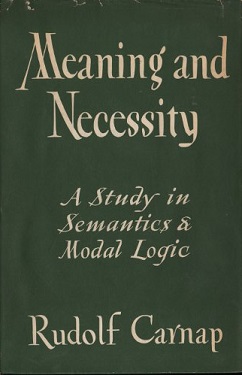Philosophy:Meaning and Necessity
 Cover of the first edition | |
| Author | Rudolf Carnap |
|---|---|
| Country | United States |
| Language | English |
| Subject | Logic |
| Publisher | University of Chicago Press |
Publication date | 1947 |
| Media type | Print (Hardcover and Paperback) |
| ISBN | ISBN:978-0226093475 |
Meaning and Necessity: A Study in Semantics and Modal Logic is a 1947 book about logic by the philosopher Rudolf Carnap.
Background
Meaning and Necessity was the culmination of Carnap's concern with the semantics of natural and formal languages, which developed subsequent to his publication of The Logical Syntax of Language in 1934.[1]
Summary
Carnap attempts to develop a new method for analyzing the meanings of linguistic expressions as well as to lay a semantic foundation for modal logic. Carnap maintains that his new method consists in doing away with the traditional assumption that linguistic expressions name concrete or abstract entities and in replacing it with the ascription to them of intensions and extensions. He states that linguistic expressions designate their intensions and extensions: every designation refers to both an intension and an extension.[2]
The intensional entities to which individual constants or descriptions, predicates, and declarative sentences are respectively said to refer are individual concepts, properties and propositions, the corresponding extensions being individuals, classes and truth-values. Carnap insists that intensions, including individual concepts, are objectively real, not mental concepts. However, he rejects the charge of hypostatization: individual concepts and properties and propositions must not be considered as things, but this does not prevent them from being genuine objective entities.[3]
Carnap's method is an alternative to Gottlob Frege's theory of sense and reference, which he refers to as the "method of extension and intension". Carnap holds that his method provides the most economical account of the logical behavior of expressions in modal contexts - for instance, the expressions '9' and '7' in the sentence '9 is necessarily greater than 7.' His criticism of Frege involves a rejection of the traditional category of names, conceived as a class of expressions each of which stands for a unique thing.[4]
Reception
Meaning and Necessity was influential, and laid the foundations of much subsequent work in the semantics of modal logic.[5] The work is seen by the British philosopher A. J. Ayer as the most important of Carnap's three books on semantics, the other two being Introduction to Semantics (1942) and Formalization of Logic (1943). Ayer criticizes the book, on the grounds that since, according to Carnap, linguistic expressions designate their intensions and extensions, it is not clear that the difference between Carnap's view and what Carnap calls the traditional assumption that linguistic expressions name concrete or abstract entities is more than nominal.[6]
References
Footnotes
Bibliography
- Books
- Ayer, A. J. (1982). Philosophy in the Twentieth Century. London: Unwin Paperbacks. ISBN 0-04-100044-7.
- Lowe, E. J. (2005). Honderich, Ted. ed. The Oxford Companion to Philosophy. Oxford: Oxford University Press. ISBN 0-19-926479-1.

